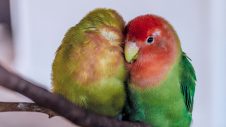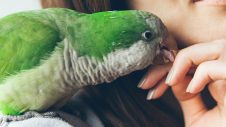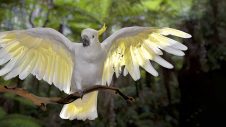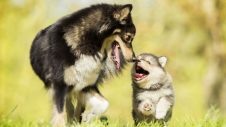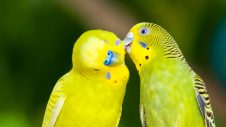Increasingly, pet birds are spending more time out of their cages as bird ownership increases, and birds become ‘mobile companions’. Even so, correct cage selection and management are important, even if the cage is only used at night or as ‘home base’.
- Buy the biggest cage you can afford, preferably the longest rather than the tallest. Tall, narrow cylindrical cages are inappropriate for most birds.
- Ensure the cage is strong enough and has straight sides for easy cleaning.
- Home made galvanized cages should be scrubbed repeatedly with a 50:50 solution of vinegar and water to neutralize the zinc coating, which can cause heavy metal poisoning.
- Don’t overcrowd the cage with toys and swings, especially if the bird is always in the cage.
- Don’t buy or use wooden barred cages for parrots or budgerigars. These are meant for canaries, but even then, they make it difficult to see the birds inside and hard to clean. AVOID THEM!!!
- Line the cage floor with newspaper or paper towels. Don’t use woodchips, shavings, sandpaper, grit or sawdust. Some cages have a wire floor or ‘suspended’ floor and this is fine, as the birds don’t have contact with their droppings.
- Perches should be natural native tree branches of various diameters, which are replaced instead of being cleaned when soiled. Don’t use metal or plastic perches and only use wooden dowels if branches aren’t available. Don’t put more than two or three perches in a cage, and don’t put them over food or water bowls, to avoid contamination.
- Don’t use sandpaper covers or perches as these can cause foot and toe damage.
- Don’t keep cages on the floor – have them at eye level or higher.
- Food and water bowls need to be cleaned daily and placed away from each other in the cage to prevent the bird ‘dunking’ its food. Hooded bowls are available, to minimize mess.
- Bird baths or a fine spray of water are appreciated by birds for preening purposes.
- Toys for cages need to be chosen carefully. Avoid hooks, wire clasps, removable bells and anything which may trap the bird or be swallowed. The best toys are often free – pine cones, seed sprays, gum nuts etc. Be aware that birds sometimes try to feed the other ‘bird’ they see in the mirror and this can be mistaken for vomiting.
When setting up an outside aviary, give consideration to all of the following:
- Aspect of facing direction – should be away from rain and wind. East to North is best.
- Materials – don’t use treated pine or softwoods.
- Roof type and floor type.
- Shade.
- Pest (vermin) control.
- Quarantine area.
- Perches.
- Placement of feeding and water bowls.
- Parasite control.
- Aviary plants.
- Breeding records.
- Hygiene and disinfection weekly.
We can advise on all these issues if you are considering building a backyard aviary. Please phone for an appointment.

 Greencross Vets
Greencross Vets 